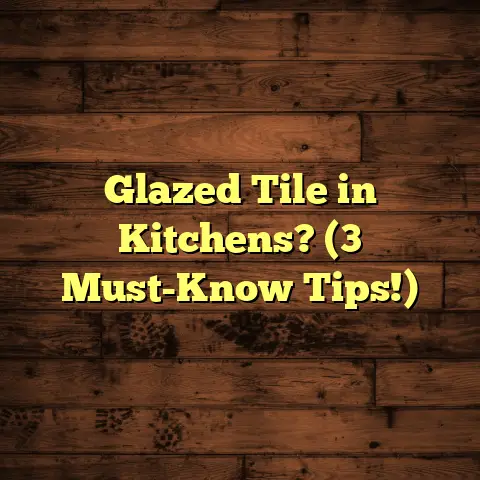Why Wood Floors Get Squeaky? (3 Causes, Act NOW!)
Wood floors.
They’re a timeless investment, right?
I’ve seen them transform houses into homes for years.
Their natural beauty adds warmth and character,
making them a top choice for homeowners.
But let’s be real.
Even the most beautiful wood floor
can develop issues.
And one of the most annoying?
Squeaking.
That’s what we’re tackling today.
Why do wood floors get squeaky, and why should
you care now?
Let’s dive in!
Section 1: Understanding the Basics of Wood Flooring
What is wood flooring, anyway?
It seems obvious,
but there’s more to it than meets the eye.
Basically, it’s any flooring made primarily of wood. But here’s where it gets interesting:
Solid Hardwood: This is the real deal.
One solid piece of wood, typically ¾ inch thick.
Think oak, maple, hickory – classic choices.Engineered Wood: This consists of a thin veneer of hardwood bonded to a core of plywood or high-density fiberboard (HDF).
It’s more stable than solid hardwood in environments with humidity swings.
Wood is a natural material.
That means it reacts
to its environment.
Think about it:
-
Humidity: Wood absorbs moisture. In humid conditions, it expands. In dry conditions, it shrinks.
-
Temperature: Temperature changes also cause expansion and contraction, although not as dramatically as humidity.
Proper installation and regular maintenance are key
to extending the life of your wood floors.
Think of
it like preventative medicine.
A little effort now can
save you a lot of headaches (and money) later.
Section 2: The 3 Main Causes of Squeaky Wood Floors
Okay, let’s get to the heart of the matter:
why are your floors singing a not-so-pleasant tune?
Here are the three main culprits I see most often:
1. Moisture and Humidity Changes
This is a big one.
Wood is hygroscopic, meaning
it readily absorbs and releases moisture from the air.
Expansion and Contraction: When humidity rises, the wood planks absorb moisture and expand.
When humidity drops, they release moisture and contract.Gaps and Movement: This constant expansion and contraction can loosen the floorboards’ grip on the subfloor.
Gaps can form, allowing the boards to rub against each other or against the nails/screws holding them down – squeak.Subfloor Issues: Moisture can also affect the subfloor (the layer beneath your wood flooring).
A damp or rotting subfloor can lose its ability to securely hold the flooring, leading to movement and, you guessed it, squeaks.
Example: Think about coastal areas or homes
without proper ventilation.
These environments
are prone to high humidity.
I’ve seen floors in
beach houses buckle and squeak like crazy because
of the constant moisture.
2. Improper Installation
This is where things can go wrong from the start.
A poorly installed floor is almost guaranteed to
squeak eventually.
Insufficient Nailing/Gluing: If the installer doesn’t use enough nails or glue to secure the floorboards to the subfloor, they’re more likely to move and squeak.
I’ve seen floors installed with staples instead of nails – a recipe for disaster.Uneven Subfloor: An uneven subfloor can create pockets of air beneath the flooring.
When you walk over these areas, the floorboards flex and squeak.
Proper subfloor preparation is crucial.Expansion Gaps: Wood floors need room to expand and contract.
If the installer doesn’t leave adequate expansion gaps around the perimeter of the room, the flooring can become stressed and squeaky.
Why Hire a Pro? I can’t stress this enough.
Hiring a qualified and experienced flooring
contractor is essential.
Yes, it might cost more
upfront, but it can save you a fortune in repairs
down the road.
They know the proper techniques,
use the right materials, and understand how to
account for environmental factors.
3. Wear and Tear Over Time
Even with the best installation, wood floors are
subject to wear and tear.
It’s inevitable.
Loosened Joints: Over time, the joints and connections between floorboards can loosen due to foot traffic, furniture movement, and temperature changes.
This loosening creates opportunities for movement and squeaking.-
Heavy Traffic Areas: Areas with heavy foot traffic (hallways, kitchens) are more prone to squeaking than areas with less traffic (bedrooms).
Aging Wood: As wood ages, it can become more brittle and prone to cracking.
This natural deterioration can contribute to squeaking.
Think of it like this: Imagine bending a paperclip
back and forth repeatedly.
Eventually, it weakens
and breaks.
The same principle applies to wood
floors.
Constant stress takes its toll.
Section 3: The Importance of Addressing Squeaky Floors Promptly
So, you’ve got squeaky floors.
What’s the big deal?
Why can’t you just live with it?
Well, here’s why you shouldn’t ignore those squeaks:
Prevent Further Damage: Squeaking is often a sign of underlying problems.
Ignoring it can allow these problems to worsen, leading to more extensive and costly repairs.Structural Issues: In some cases, squeaky floors can indicate structural problems with the subfloor or even the joists beneath.
These issues need to be addressed promptly to prevent further damage to your home’s structure.Costly Repairs: The longer you wait to address squeaky floors, the more expensive the repairs are likely to be.
A simple fix today could prevent a major renovation tomorrow.Home Comfort and Enjoyment: Let’s be honest, squeaky floors are annoying!
They detract from the overall comfort and enjoyment of your home.
Addressing them can significantly improve your quality of life.
Real-Life Example: I once worked on a house where
the homeowners ignored a small squeak in their
living room for years.
Eventually, it turned into
a major problem.
The subfloor had rotted due to
a hidden water leak, and the entire floor had to
be replaced.
They ended up spending thousands
of dollars more than they would have if they had
addressed the issue sooner.
Here’s a Table Showing Potential Cost Increases Based on Delaying Repair (These are estimates and can vary greatly by location and severity of the issue):
Source: Based on average project costs reported by
home improvement professionals and industry
publications.
Disclaimer: These are estimates only.
Actual costs
may vary.
So, what should you do if you notice squeaky floors?
Investigate: Try to pinpoint the source of the squeak.
Walk around the area and see if you can identify the specific board(s) that are causing the problem.-
Check for Moisture: Look for signs of moisture damage, such as water stains, mold, or mildew.
Call a Professional: If you’re not comfortable diagnosing and repairing the problem yourself, call a qualified flooring contractor.
They can assess the situation and recommend the best course of action.
Don’t wait! The sooner you address squeaky
floors, the better.
It’s an investment in the
longevity and beauty of your home.
Conclusion
Wood floors are a beautiful and enduring choice
for any home.
But like any investment, they require
attention and care.
Understanding the causes of
squeaky floors is the first step in maintaining their
beauty and functionality.
Don’t ignore those squeaks!
Take action as soon
as you notice them.
A little preventative maintenance
can go a long way in ensuring that your wood floors
remain a cherished part of your home for years to come.
I hope this article has been helpful.
Remember,
I’m always here to answer your flooring questions.
Feel free to reach out if you need assistance.
Happy flooring!





